Perm
| Perm (English) Пермь (Russian) Перем (Komi-Permyak) |
|
|---|---|
| — Inhabited locality — | |
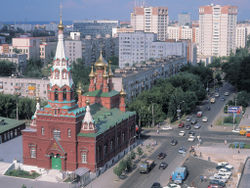 View of Perm |
|
.svg.png) Location of Perm Krai in Russia |
|
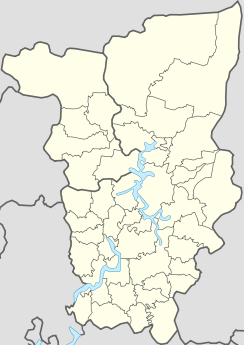 Perm
|
|
| Coordinates: | |
 |
 |
| Holiday | June 12 |
| Administrative status | |
| Country | Russia |
| Federal subject | Perm Krai |
| Administrative center of | Perm Krai, Permsky District |
| Municipal status | |
| Urban okrug | Perm Urban Okrug |
| City Head | Igor Shubin |
| Representative body | City Duma |
| Statistics | |
| Area | 799.68 km2 (308.76 sq mi) |
| Population (2002 Census) | 1,001,653 inhabitants[1] |
| - Rank | 13th |
| - Density | 1,253 /km2 (3,250 /sq mi)[2] |
| Time zone | YEKT/YEKST (UTC+5/+6) |
| Founded | May 15, 1723 |
| Previous names | Yegoshikha (until 1940), Molotov (until October 2, 1957) |
| Postal code(s) | 614xxx |
| Dialing code(s) | +7 342 |
| Official website | |
Perm (Russian: Пермь [ˈpʲɛrmʲ];[3] Komi-Permyak: Перем, Perem; Komi: Перым, Perym) is a city and the administrative center of Perm Krai, Russia. It is situated on the banks of the Kama River, in the European part of Russia near the Ural Mountains.
Perm's 2007 estimated population was 990,200 (2007 est.)[4], down from 1,001,653 recorded in the 2002 Census and 1,090,944 recorded in 1989 Census. As of the 2002 Census, the city was the thirteenth most populous in Russia.
Perm is served by Bolshoye Savino Airport and hosts Bakharevka air base.
The word "Perm" is probably Komi or Veps in origin. "Parma" is translated from Komi-Permyak language as a hilly place, covered with woods. Alternately, the name may originate from the Veps term "Pera maa" or "Perama" (distant land in English). It is widely believed that geologist, Sir Roderick Murchison coined the name of the Permian geologic period from the city, but the period was actually named for the ancient kingdom of Permia.
Contents |
Geography

Perm covers an area of 799.68 square kilometers (308.76 sq mi).
The city of Perm is located on the bank of the Kama River upon hilly terrain. The Kama is the main tributary of the Volga River and one of the deepest and most picturesque rivers of Russia. This river is the waterway which grants the Urals access to the White Sea, Baltic Sea, Sea of Azov, Black Sea, and Caspian Sea. Kama divides the city into two parts, the central part and the right bank part, and it stretches for 70 km along the Kama and 40 km across it. The city street grid parallels the Kama River, traveling generally east-west, while other main streets run perpendicularly to those following the river. The grid pattern accommodates the hills of the city where it crosses them.
Another distinguishing feature of the city's relief is the large quantity of small rivers and brooks. The largest of them are the Mulyanka, Yegoshikha, Motoviliha (all are on the left bank of Kama River), and Gaiva (on the right bank).
Perm has a continental climate with warm summers and long, cold winters.
History
During the early Middle Ages, the region of Perm was populated by pagan Finno-Ugric tribes who lived to the southeast of the legendary Bjarmaland and northeast of Volga Bulgaria. Between the 13th and 14th centuries, Russian fur traders and Christian missionaries from Novgorod and later Moscow founded the first settlements in the area. Saint Stephen of Perm is credited with the conversion of the local population to Christianity in the late 14th century. In the 15th century, the Perm region, because of its highly profitable fur trade, was an object of a bitter rivalry between Novgorod and Moscow, and in 1472 Perm was finally annexed by the Grand Duchy of Moscow. In the late 15th and early 16th centuries, soldiers, merchants, Christian monks, and priests were followed by Tsarist administration officials and peasant settlers from western Russia.
Perm was first mentioned as a village, Yegoshikha, in 1647; however, the history of the modern city of Perm starts with the development of the Ural region by Tsar Peter I of Russia. Vasily Tatishchev, appointed by the Tsar as a chief manager of Ural factories, founded Perm together with another major center of the Ural region, Yekaterinburg.
Perm was founded on May 15 (May 4 in Julian calendar), 1723, and has had town status since October 29, 1781. By 1797, it was already an administrative center of the gubernia with the same name.

In the 19th century, Perm became a major trade and industrial center with a population of more than 20,000 people in the 1860s, with several metallurgy, paper, and steamboat producing factories, including one owned by a British entrepreneur. In 1870, an opera theatre was opened in the city, and in 1871 the first phosphoric factory in Russia was built. In 1916, Perm State University — a major educational institution in modern Russia — was opened.
After the outbreak of the Russian Civil War, Perm became a prime target for both sides because of its military munitions factories. In December 1918 the Siberian White Army under Anatoly Pepelyayev (who acknowledged the authority of the Omsk Government of Aleksandr Kolchak), took Perm. In 1919 the city was retaken by the Red Army.
Grand Duke Mikail Alexandrovich was executed in the outskirts of Perm with his secretary Nicholas Johnson on June 12, 1918 on the orders of the Perm Cheka. Their bodies were never recovered. A few weeks later on July 7, 1918, Andronic Nikolsky, the Archbishop of Perm, was also murdered by the Bolsheviks in the city. In 2000, the Russian Orthodox Church glorified him as Hieromartyr Andronik, Archbishop Of Perm, one of the Russian New Martyrs and Confessors.
.jpg) General view of City of Perm |
.jpg) General view of the city of Perm from Gorodskie Gorki |
.jpg) Razguliai, outskirts of the city of Perm |
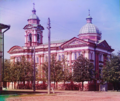 Mary Magdalene Church of the city Perm |
 Summertime location of the exchange in the city Perm |
 Prokudin-Gorskii - Staro-Sibirskaia Gate in the city of Perm |
 Kama river near Perm. The bridge still stands today, but another similar bridge has been built along side it. Both are painted white. |
 Headquarters of the Ural Railway Administration in the city of Perm |
Soviet Times
In the 1930s, Perm grew as a major industrial city with aviation, shipbuilding, and chemical factories built during that period. Development continued after the 1940s and virtually every major industry became represented by numerous factories in Perm. To this day, almost 80% of the city's population is employed in manufacturing. During the Great Patriotic War (World War II), Perm was a vital center of artillery production in the Soviet Union.
From 1940 until 1957, the city was named Molotov (Мо́лотов), after Vyacheslav Molotov.
Modern city

The city is a major administrative, industrial, scientific, and cultural center. The leading industries include machinery, defence, oil production (about 3% of Russian output), oil refining, chemical and petrochemical, timber and wood processing and the food industry.
Administrative divisions
.svg.png)
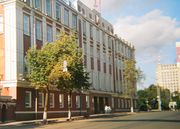
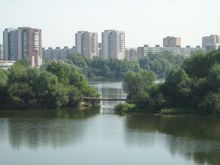
Perm is divided into seven city districts:
| City District | Population (2002 Census) |
|---|---|
| Dzerzhinsky (Дзержи́нский) | 153,403 |
| Industrialny (Индустриа́льный) | 160,039 |
| Kirovsky (Ки́ровский) | 126,960 |
| Leninsky (Ле́нинский) | 57,569 |
| Motovilikhinsky (Мотови́лихинский) | 176,564 |
| Ordzhonikidzevsky (Орджоники́дзевский) | 11,631 |
| Sverdlovsky (Свердло́вский) | 215,487 |
Culture
The Perm Opera and Ballet House is the one of the best in Russia[5]. There are many other theatres in Perm, including the Drama theatre, the Puppet Theatre, the Theatre for Young Spectators, and the Theatre "Near Bridge". [[Perm Opera and Ballet Theatre, 2007.jpg|thumb|Perm Opera and Ballet House]]

Among the cities museums and galleries, the Perm State Art Gallery is recognized for its outstanding collections of art, including paintings from the 15th to 18th century art movements, and wooden sculptures from the region. It is housed in a notable early 19th century structure, once an orthodox cathedral. The spire of the museum towers over the rest of Perm, as it is situated on the Komsomolsky Prospect. [1] [6] Perm is receiving attention from the development of the new Museum of Contemporary Art, which came into existence officially in March 2009. [7][8]
On 4 December 2009 a fire in one of Perm's well-known evening venues, the ‘Lame Horse’ night club killed more than 100 people.[9][10][11][12][13][14] The club was holding a large party to celebrate its eighth anniversary, when the fire erupted, reported to have been caused by outdoor fireworks igniting low-hanging decorative plastic sheeting attached to the club's wooden ceiling. Invited guests are reported to have included many of the club owners' family members and friends.[15]
Education
Perm is a scientific center; some of the scientific institutes are combined in the Perm Scientific Center of the Ural Branch of the Russian Academy of Sciences.
Perm is a home to several major universities including Perm State University [16], Perm State Technical University [17], Perm State Teachers' Training University, Perm State Medical Academy [18], Perm State Pharmaceutical Academy [19], Perm State Agricultural Academy, The Institute of Art and Culture, Perm State Choreographic School[20], Perm branch of state university Higher school of economics [21] and others. There are also three military schools in Perm.
Transport
Perm is an important railway junction on the Trans-Siberian Railway with lines radiating to Central Russia, the north part of the Urals, and the far east of Russia. The Kama River is an important link in the unifying deep-water system of the European part of Russia. The river connects the city with European waterways. It is possible to ship cargo from the Kama river area to the sea ports of the White, Baltic, Azov, Black, and Caspian seas without reloading.[22]
Perm is served by the international airport Bolshoye Savino, 16 km south-west.
Perm's public transit network includes tram, bus, and trolleybus routes.
International relations
Twin towns - Sister cities
Perm is twinned with:
 Louisville, since 1994
Louisville, since 1994 Oxford, United Kingdom, 1995
Oxford, United Kingdom, 1995 Duisburg, Germany, since 2007[23][24]
Duisburg, Germany, since 2007[23][24]
Sport
The three main professional sports played in Perm are football, ice hockey and basketball. The largest football club in Perm is Amkar, who play in the Russian Premier League[25]. Perm is also home to the two-time Russian Basketball Super League champions, Ural Great. The largest Ice hockey team based in Perm is Molot-Prikame Perm who play in the Vysshaya Liga.[26]
Notable citizens
- See: Category:People from Perm
The following people were either born in Perm or made names for themselves while residing there.
- Viktor Petrovich Astafiyev, a Russian writer of short stories and novels;
- Tatiana Borodina, opera soprano;
- Sergei Diaghilev, ballet impresario;
- Alexey Victorovich Ivanov, a modern Russian writer;
- Fyodor Gral, a doctor.
.jpg)
- Alexandra Kosteniuk, chess Grandmaster;
- Dmitry Mamin-Sibiryak, a Russian author;
- Nikolai Moiseev, a astronomer;
- Fyodor Petrov was a Soviet artillery designer;
- Natasha Poly, a Russian supermodel.
- Alexander Stepanovich Popov, physicist who was the first to demonstrate the practical application of electromagnetic waves (radio);
- Arkadiy Dmitrievich Shvetsov, a Soviet aircraft engine designer;
- Nikolai Slavyanov, the inventor of new method in arc welding;
- Peter Berngardovich Struve, a Russian political economist, philosopher and editor;
- Yuri Trutnev, a Minister of Natural Resources of the Russian Federation;
- Andrey Nikoforovich Voronikhin, a Russian architect and painter. As a representative of classicism he was also one of the founders of the monumental Russian Empire style;
- Konstantin Zyryanov, a Russian footballer.
- Alex Wiens, Murderer of Marwa El-Sherbini.
See also
- Saint Stephen of Perm
- Yegoshikha River
- Great Perm
References
- Notes
- ↑ Федеральная служба государственной статистики (Federal State Statistics Service) (2004-05-21). "Численность населения России, субъектов Российской Федерации в составе федеральных округов, районов, городских поселений, сельских населённых пунктов – районных центров и сельских населённых пунктов с населением 3 тысячи и более человек (Population of Russia, its federal districts, federal subjects, districts, urban localities, rural localities—administrative centers, and rural localities with population of over 3,000)" (in Russian). Всероссийская перепись населения 2002 года (All-Russia Population Census of 2002). Federal State Statistics Service. http://perepis2002.ru/ct/html/TOM_01_04_1.htm. Retrieved 2009-08-19.
- ↑ The value of density was calculated automatically by dividing the 2002 Census population by the area specified in the infobox. Please note that this value may not be accurate as the area specified in the infobox does not necessarily correspond to the area of the entity proper or is reported for the same year as the Census (2002).
- ↑ Gramota.ru. #18475
- ↑ Perm citizens — The Official website of Perm Administration.
- ↑ Барыкина Л. Пермяки высадились на Манхэттене//Ведомости от 25.01.2008
- ↑ The City of Perm: ART, CULTURE, SPORT
- ↑ Perm Museums' Plan Dubbed the 'New Bilbao' | News | The Moscow Times
- ↑ Kishkovsky, Sophia (2009-05-28). "Modern Dance and Art Bring a Burst of Color to a Gray City". The New York Times. http://www.nytimes.com/2009/05/28/world/europe/28perm.html?ref=global-home. Retrieved 2010-05-22.
- ↑ "BBC News - Explosion in Russian nightclub 'kills scores'". news.bbc.co.uk. 2009-12-05. http://news.bbc.co.uk/1/hi/uk/8396671.stm. Retrieved 2009-12-05.
- ↑ "Russia: Explosion In Nightclub In Perm Kills 100 People, Reports Say". news.sky.com. http://news.sky.com/skynews/Home/World-News/Russia-Explosion-In-Nightclub-In-Perm-Kills-76-People-Reports-Say/Article/200912115491710?f=rss. Retrieved 2009-12-05.
- ↑ "Russian Nightclub Explosion Kills At Least 100 In Perm: Reports - The Two-Way - Breaking News, Analysis Blog : NPR". npr.org. http://www.npr.org/blogs/thetwo-way/2009/12/russian_nightclub_explosion_ki.html. Retrieved 2009-12-05.
- ↑ "100 Killed in Explosion @ Perm, Russia Night Club". www.oliverwillis.com. http://www.oliverwillis.com/2009/12/04/100-killed-in-explosion-russian-night-club/. Retrieved 2009-12-05.
- ↑ "Nightclub explosion in Perm, Russia kills more than 100 people". www.nowpublic.com. http://www.nowpublic.com/world/nightclub-explosion-perm-russia-kills-more-100-people. Retrieved 2009-12-05.
- ↑ "Perm, Russia Nightclub Explosion Kills More Than 100: Reports". www.huffingtonpost.com. http://www.huffingtonpost.com/2009/12/04/russia-nightclub-explosio_n_380820.html. Retrieved 2009-12-05.
- ↑ "Число погибших в ночном клубе в Перми превысило 100 человек" (in Russian). Lenta.ru (Rambler Media Group). 5 December 2009. http://www.lenta.ru/news/2009/12/05/club3/. Retrieved 5 December 2009.
- ↑ Perm State University
- ↑ Заставка - Пермский государственный технический университет
- ↑ Perm State Academy Of Medicine
- ↑ http://www.psfa.ru/english/
- ↑ Perm State Ballet college
- ↑ Государственный университет - Высшая школа экономики
- ↑ Transport infrastructure — Perm regional server.
- ↑ "Cities Twinned with Duisburg". 2009 Duisberg City Council. http://www.duisburg.de/micro/english/introducing/102010100000187829.php. Retrieved 2009-09-09.
- ↑ "List of Twin Towns in the Ruhr Destrict". © 2009 Twins2010.com. http://www.twins2010.com/fileadmin/user_upload/pic/Dokumente/List_of_Twin_Towns_01.pdf?PHPSESSID=2edd34819db21e450d3bb625549ce4fd. Retrieved 2009-10-28.
- ↑ Matches Perm sports clubs
- ↑ Perm, Russia - Perm city information
External links
- Perm regional server
- The Official Website of the Perm Municipal Duma
- Official Perm City website
- Street View of Perm
- Perm Chamber of Commerce and Industry
- The Western Ural Photographic Album
- Virtual museum of Romanov in Perm
- History of Perm
- Perm and Perm Region Information on Kommersant Publishing webpage (also, see all other Russian subjects of the Federation)
- The city of Perm - The poem of the town
- Perm for travelers Sights of Perm and Perm's region
- General info on the city of Perm
- "The Perm Days" is the regional newspaper issued in English language. That is an investment, business, tourist guide for foreign guests of Perm Krai.
- Article about Perm Ballet
- S. Kishkovsky "Modern Dance and Art Bring a Burst of Color to a Gray City"
- Pictures
- About Perm.
Education
- Perm State University
- Perm State Technical University
- Perm State Medical Academy
- Perm State Pharmaceutical Academy
- Perm State Choreographic School
|
||||||||||||||||||||